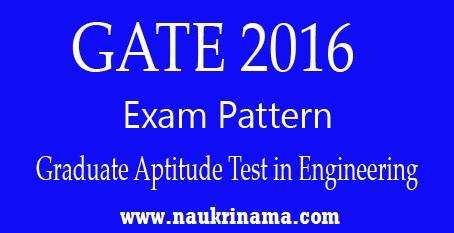GATE 2016 Online Exam Pattern and Marking Scheme


GATE 2016 examination is conducted for admission to Post graduate engineering courses. The GATE 2016 will jointly administer by the IISc and seven IIT’s namely Mumbai, Delhi, Kanpur, Roorkee, Madras, Kharagpur, Guwahati. The candidates who qualify the GATE exam and pursue the Masters programs and direct doctoral programs in Engineering, Technology, Architecture and doctoral programs will be given financial assistance by MHRD, government of India. Here, is the exam pattern and marking scheme of GATE 2016.
GATE 2016 Online Exam Pattern and Marking Scheme
| Name of Exam | Type of exam | Examination Duration | Total questions | Total marks |
| Graduate Aptitude Test in Engineering (GATE) | Multiple Choice Questions (MCQ) | 3 Hours | 65 | 100 |
Types of Questions in GATE 2016:
| Multiple Choice Questions |
|
| Numerical Questions |
|
General Aptitude (GA) Questions:
- This is a mandatory section for all papers.
- The GA section includes 5 questions carrying 1 mark each (sub-total 5 marks) and 5 questions carrying 2 marks each (sub-total 10 marks).
- The GA questions carry a total of 15 marks
GATE 2016 Exam Pattern with code:-
| S.No | GATE 2016 Paper | Code | Exam Pattern |
| 1 | Aerospace Engineering | AE | The Engineering Mathematics section will carry around 15% of the total marks,The General Aptitude section will carry 15% of the total marksThe remaining 70% percentage of the total marks is devoted to the subject of the paper. Except GG & XE all papers have: 1 Mark questions: 25 questions 2 Marks questions: 30 questions Total Questions are 55 and
|
| 2 | Agricultural Engineering | AG | |
| 3 | Biotechnology | BT | |
| 4 | Civil Engineering | CE | |
| 5 | Chemical Engineering | CH | |
| 6 | Computer Science and Information Technology | CS | |
| 7 | Electronics and Communication Engineering | EC | |
| 8 | Electrical Engineering | EE | |
| 9 | Instrumentation Engineering | IN | |
| 10 | Mechanical Engineering | ME | |
| 11 | Mining Engineering | MN | |
| 12 | Metallurgical Engineering | MT | |
| 13 | Petroleum Engineering | PE | |
| 14 | Production and Industrial Engineering | PI | |
| 15 | Textile Engineering and Fibre Science | TF | |
| 16 | Engineering Sciences | XE* | |
| 17 | Life Sciences | XL* | General Aptitude section will carry 15% of the total marks and the remaining 85% of the total marks is devoted to the subject of the paper. |
| 18 | Architecture and Planning | AR | |
| 19 | Chemistry | CY | |
| 20 | Ecology and Evolution | EY | |
| 21 | Geology and Geophysics:In addition to General Ability, the Question Paper will have Part A common & compulsory for all candidates with 25 questions of 1 markPart B has Section 1 (Geology) and Section 2 (Geo-physics). Candidates can answer any one section30 questions for 2 marks each | GG* | |
| 22 | Mathematics | MA | |
| 23 | Physics | PH |
Question Papers other than GG, XE and XL
These papers would contain 25 questions carrying 1 mark each and 30 questions carrying 2 marks each . The question paper will consist of questions of multiple choice and numerical answer type. For numerical answer questions, choices will not be given.
GG (Geology and Geophysics) Paper
Apart from the General Aptitude (GA) section, the GG question paper consists of two parts: Part A and Part B.
- Part A is common for all candidates
- Part B contains two sections: Section 1 (Geology) and Section 2 (Geo-physics
- Candidates will have to attempt questions in Part A and either Section 1 or Section 2 in Part B.
Part A consists of 25 multiple-choice questions carrying 1-mark each (sub-total 25 marks and some of these may be numerical answer type questions). Each section in Part B (Section 1 and Section 2) consists of 30 multiple choice questions carrying 2 marks each (sub-total 60 marks and some of these may be numerical answer type questions).
XE Paper (Engineering Sciences)
In XE paper, Engineering Mathematics section (Section A) is compulsory. This section contains 11 questions carrying a total of 15 marks:
- 7 questions carrying 1 mark each (sub-total 7 marks)
- 4 questions carrying 2 marks each (sub-total 8 marks).
- Some questions may be of numerical answer type questions.
Each of the other sections of the XE paper (Sections B through G) contains 22 questions carrying a total of 35 marks: 9 questions carrying 1 mark each (sub-total 9 marks) and 13 questions carrying 2 marks each (sub-total 26 marks). Some questions may be of numerical answer type.
XL Paper (Life Sciences)
In XL paper, Chemistry section (Section H) is compulsory. This section contains 15 questions carrying a total of 25 marks:
- 5 questions carrying 1 mark each (sub-total 5 marks)
- 10 questions carrying 2-marks each (sub-total 20 marks)
- Some questions may be of numerical answer type.
Each of the other sections of the XL paper (Sections I through M) contains 20 questions carrying a total of 30 marks: 10 questions carrying 1 mark each (sub-total 10 marks) and 10 questions carrying 2 marks each (sub-total 20 marks). Some questions may be of numerical answer type.
Marking Scheme
- There will be negative marking.
- For 1-mark questions, 1/3 mark will be deducted for a wrong answer.
- For 2-mark questions, 2/3 mark will be deducted for a wrong answer
- There is no negative marking for Numerical questions
Design of Questions in the GATE 2016 Paper:
The questions may be designed to test the following abilities:
(i) Recall: These are based on facts, principles, formulae or laws of the discipline of the paper. The candidate is expected to be able to obtain the answer either from his/her memory of the subject or at most from a one-line computation.
(ii) Comprehension: These questions will test the candidate’s understanding of the basics of his/her field, by requiring him/her to draw simple conclusions from fundamental ideas.
(iii) Application: In these questions, the candidate is expected to apply his/her knowledge either through computation or by logical reasoning.
(iv) Analysis and Synthesis: In these questions, the candidate is presented with data, diagrams, images etc. that require analysis before a question can be answered. A Synthesis question might require the candidate to compare two or more pieces of information. Questions in this category could, for example, involve candidates in recognizing unstated assumptions, or separating useful information from irrelevant information
GATE 2016 Online Exam-Application Form, Date, Eligibility Details: CLICK HERE
To get more exam notification click here
For official website of GATE 2016: CLICK HERE
Graduate Aptitude Test in Engineering (GATE) is conducted jointly by the Indian Institute of Science and seven Indian Institutes of Technology on behalf of the National Coordination Board .GATE is the Department of Higher Education, Ministry of Human Resources Development (MHRD) and Government of India. It is an all-India examination that primarily tests the comprehensive understanding of various undergraduate subjects in engineering and science.
The GATE score of a candidate reflects the relative performance level of a candidate. The score is used for admissions to various post-graduate education programs in Indian higher education institutes, with financial assistance provided by MHRD and other government agencies. Recently, GATE scores are also being used by several Indian public sectors for recruiting graduate engineers in entry-level positions. It is one of the most competitive examinations in India.
